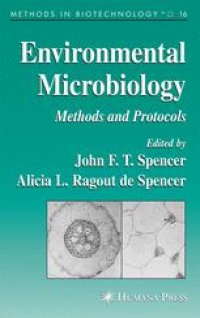
Ebook: Environmental Microbiology: Methods and Protocols
- Tags: Microbiology
- Series: Methods in Biotechnology 16
- Year: 2004
- Publisher: Humana Press
- Edition: 1
- Language: English
- pdf
Understanding the relationship between a microorganism and its environment is essential to the successful manipulation of industrial, biochemical, and medical processes. In Environmental Microbiology: Methods and Protocols, highly practiced experimentalists who often have perfected the methods they write about describe readily reproducible techniques for determining most of the important factors governing microorganisms and their habitats. Presented in step-by-step detail, these cutting-edge methods range from those for the study of marine organisms, to those for investigating microorganisms occurring in groundwater, to the biodiversity found in remote environments. The protocols for studying fermented milks are significant for investigators concerned with milk as an item of food for infants, small children, and even adults. Additional methods for the recovery and determination of nucleic acids and other compounds affecting, and affected by, microorganisms, are provided for certain enzymes produced by plant pathogens and for obtaining microbial species tolerant of such inhibitors as heavy metals. Review articles discuss the endophytic bacterium Bacillus mojavensis, the engineering of bacteria to enhance their ability to carry out bioremediation of aromatic compounds, and the use of chemical shift reagents and Na-NMR to study sodium gradients in microorganisms. The protocols follow the successful Methods in Molecular Biology™ series format, each one offering step-by-step laboratory instructions, an introduction outlining the principle behind the technique, lists of equipment and reagents, and tips on troubleshooting and avoiding known pitfalls.
State-of-the-art and highly practical, Environmental Microbiology: Methods and Protocols offers microbiological researchers a powerful set of techniques for investigating and understanding microorganisms in their native environments.
Understanding the relationship between a microorganism and its environment is essential to the successful manipulation of industrial, biochemical, and medical processes. In Environmental Microbiology: Methods and Protocols, highly practiced experimentalists who often have perfected the methods they write about describe readily reproducible techniques for determining most of the important factors governing microorganisms and their habitats. Presented in step-by-step detail, these cutting-edge methods range from those for the study of marine organisms, to those for investigating microorganisms occurring in groundwater, to the biodiversity found in remote environments. The protocols for studying fermented milks are significant for investigators concerned with milk as an item of food for infants, small children, and even adults. Additional methods for the recovery and determination of nucleic acids and other compounds affecting, and affected by, microorganisms, are provided for certain enzymes produced by plant pathogens and for obtaining microbial species tolerant of such inhibitors as heavy metals. Review articles discuss the endophytic bacterium Bacillus mojavensis, the engineering of bacteria to enhance their ability to carry out bioremediation of aromatic compounds, and the use of chemical shift reagents and Na-NMR to study sodium gradients in microorganisms. The protocols follow the successful Methods in Molecular Biology™ series format, each one offering step-by-step laboratory instructions, an introduction outlining the principle behind the technique, lists of equipment and reagents, and tips on troubleshooting and avoiding known pitfalls.
State-of-the-art and highly practical, Environmental Microbiology: Methods and Protocols offers microbiological researchers a powerful set of techniques for investigating and understanding microorganisms in their native environments.
Understanding the relationship between a microorganism and its environment is essential to the successful manipulation of industrial, biochemical, and medical processes. In Environmental Microbiology: Methods and Protocols, highly practiced experimentalists who often have perfected the methods they write about describe readily reproducible techniques for determining most of the important factors governing microorganisms and their habitats. Presented in step-by-step detail, these cutting-edge methods range from those for the study of marine organisms, to those for investigating microorganisms occurring in groundwater, to the biodiversity found in remote environments. The protocols for studying fermented milks are significant for investigators concerned with milk as an item of food for infants, small children, and even adults. Additional methods for the recovery and determination of nucleic acids and other compounds affecting, and affected by, microorganisms, are provided for certain enzymes produced by plant pathogens and for obtaining microbial species tolerant of such inhibitors as heavy metals. Review articles discuss the endophytic bacterium Bacillus mojavensis, the engineering of bacteria to enhance their ability to carry out bioremediation of aromatic compounds, and the use of chemical shift reagents and Na-NMR to study sodium gradients in microorganisms. The protocols follow the successful Methods in Molecular Biology™ series format, each one offering step-by-step laboratory instructions, an introduction outlining the principle behind the technique, lists of equipment and reagents, and tips on troubleshooting and avoiding known pitfalls.
State-of-the-art and highly practical, Environmental Microbiology: Methods and Protocols offers microbiological researchers a powerful set of techniques for investigating and understanding microorganisms in their native environments.
Content:
Front Matter....Pages i-xiv
Front Matter....Pages 1-1
Front Matter....Pages 3-9
Front Matter....Pages 11-22
Front Matter....Pages 23-37
Front Matter....Pages 39-50
Back Matter....Pages 51-74
....Pages 75-82